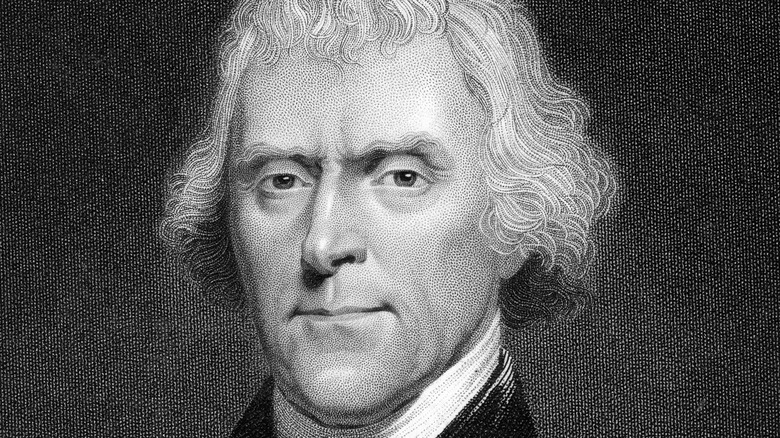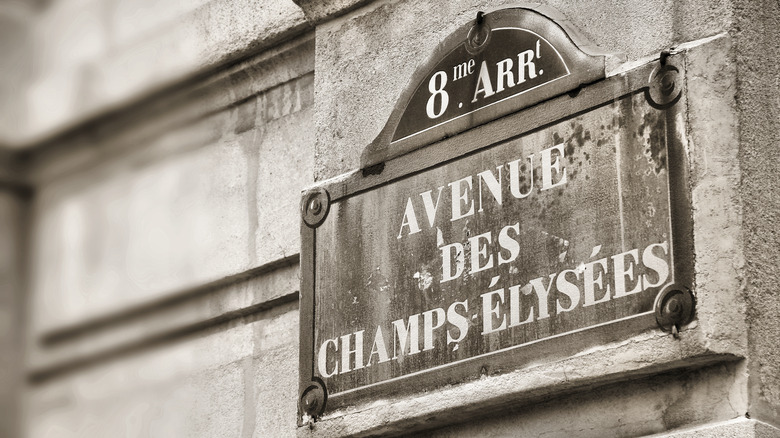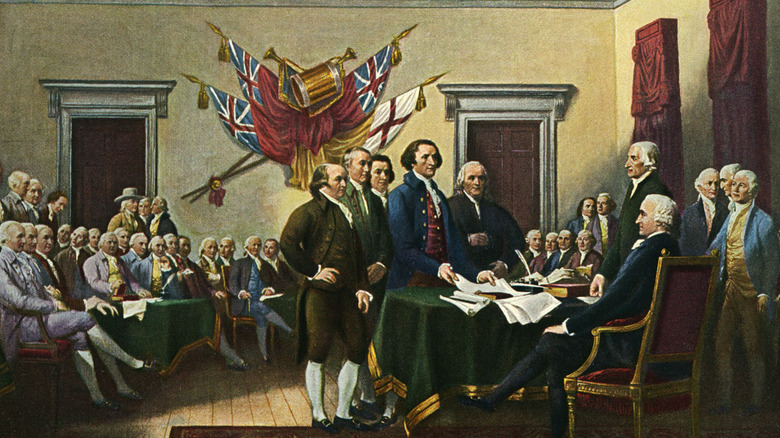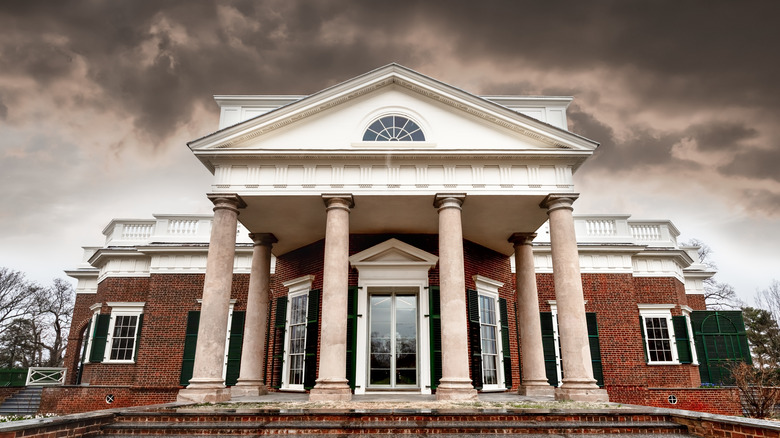The Truth About Thomas Jefferson And Sally Hemings
Like any complex historical figure, pinning down the facts of Thomas Jefferson's life and legacy has not been an easy task. For nearly two centuries, historians have quibbled about the third president's interactions with an enslaved woman named Sally Hemings, whom he held in bondage for most of her life. She bore at least six of his children (via Monticello), four of whom survived childhood. While past historians referred to their dynamic as a relationship or even an affair, contemporary historians take a more cautious approach.
The curators at Monticello, Jefferson's self-designed neoclassical plantation home, grappled with how to tell Hemings' story. Since no image of Hemings exists, they cast a woman's shadow on the recently restored slave quarters wall to symbolize her existence. Excerpts of her son's documents and correspondence tell her story (per The New York Times).
The Monticello historians stick with the facts regarding Hemings and Jefferson and ask questions about the unknown. "We really can't know what the dynamic was," explains Leslie Greene Bowman, president of the Thomas Jefferson Foundation, to The New York Times. "Was it rape? Was there affection? We felt we had to present a range of views, including the most painful one."
What curators make plain is that enslaved women didn't have the right to consent. Essentially, saying no to sexual advances wasn't an option. Nonetheless, the documented facts of Hemings' life tell the story of a keen negotiator who used what agency she had to secure a better life for her children (per Monticello).
What do we know about Sally Hemings?
Sally Hemings was born in 1773 to Elizabeth Hemings, an enslaved woman. John Wayles, Thomas Jefferson's father-in-law, fathered Sally and held Elizabeth and her children in bondage. Sally and Jefferson's wife, Martha Jefferson, were half-sisters. After Wayles died, Sally and her family moved to Monticello as a part of Martha's inheritance. There, Sally labored as the nursemaid and then lady's maid to Jefferson's daughter Maria (via Monticello).
When Sally was 14, she accompanied the Jefferson family to Paris, continuing to serve Jefferson's two daughters. Historians know little about her daily life in France. However, one can imagine the striking contrast between a Virginia plantation and the bustling Paris, already a global hub of arts, culture, and intellectual thought. Sally learned to speak French during her time there, was sometimes paid for her work, and accompanied the Jefferson sisters on outings. Most importantly, she was legally free (per Monticello).
There, sexual relations began between Jefferson and Hemings, though the details of the dynamic are unknown. When Sally was 16, Jefferson prepared to return to Virginia. Pregnant at the time, Sally refused to go back. Through negotiations, she secured the freedom of her future children and relatively more comfortable living conditions if she returned. Historian Annette Gordon-Reed Hemings asserts that Hemings "helped shape her life and the lives of her children, who got an almost 50-year head start on emancipation, escaping the system that had engulfed their ancestors and millions of others" (via Monticello).
DNA evidence provides clarity
Portrayals of Jefferson and Hemings have been ambivalent. During their lifetimes, political cartoons mocked them. Some of Jefferson's family members denied their connection to the Hemings children (via Monticello). In contrast, the 1995 movie "Jefferson in Paris" imagined the Jefferson/Hemings dynamic as a love story (per The New York Times). Whereas The Washington Post reported in 2017 when archeologists excavated Monticello's slave quarters, journalist Britni Danelle contended that the Hemings and Jefferson interactions should be called rape.
Most of what we know about Hemings' life came from her son Madison's accounts that cite Jefferson as the father of her children, without elaboration (per Monticello). To further support Madison's writing, a study of DNA evidence, published in the scientific journal Nature in 1998, confirmed that Jefferson was indeed the father of Hemings' children. The evidence was so compelling that the Thomas Jefferson Foundation released a statement expressing its view that "the issue is a settled historical matter." The foundation recognized the "considerable body of evidence stretching from 1802 to 1873 (and beyond)" that was corroborated by the DNA study and proved Jefferson's paternity of Sally Hemings' children.
The DNA study found that the male-line descendants of Hemings' son Easton had Jefferson DNA. This discovery verified Madison's story and refuted the narratives told by Jefferson's "legitimate" grandchildren. Madison Hemings was even registered as Jefferson's son in the 1870 census. And these are just the first few pieces in a long list of evidence confirming that Jefferson fathered Sally's children.
Other founding fathers most likely knew of Hemings
Thomas Jefferson and Sally Hemings seemed to be an open secret during their lifetimes. In 1802, journalist James Callender accused Jefferson in the Federalist newspaper the Recorder: "It is well known that the man, whom it delighteth the people to honor, keeps, and for many years past has kept, as his concubine, one of his own slaves. Her name is SALLY," wrote Callender (via Digital History at the University of Houston). At the time, a concubine meant a woman who had sexual contact with a man but was not married to him (per Monticello).
Recent scholarship suggests that Callender's 1802 exposé came as no surprise to his contemporaries. Callender himself wrote that it had "once or twice been hinted at" in newspapers in 1800 and 1801. Though, his article has been considered the first significant mention of Hemings. However, in 2016 Trinity College professor Mark Silk claimed to have found references to the affair that predate the 1802 exposé by over eight years (via Smithsonian Magazine).
John Adams wrote to his sons in 1794, said Silk, referring — indirectly — to Hemings as Egeria, a nymph from Roman mythology. In later correspondence, he compared Jefferson to King Numa of Rome, who according to the poet Ovid slept with Egeria before returning to Rome to rule for 43 years. Silk called the letters "tangible evidence" that at least one other leading political family of the day knew of the sexual relations between Jefferson and Hemings.
How did Jefferson view slavery?
The author of the words, "all men are created equal," held more than 600 people in slavery during his lifetime (per The Whitehouse Historical Association). However, Jefferson began his political career in vehement opposition to slavery. He attempted to add a passage to the declaration of independence that would essentially eliminate slavery from the country, and he called the slave trade an "assemblage of horrors" and a "cruel war against human nature itself, violating its most sacred rights of life & liberties" (via Smithsonian Magazine).
Though Jefferson's early writing railed against slavery, his protestations turned to silence. He began to reap the profits from the sale of enslaved people. Additionally, he enjoyed the ease of life at his Monticello estate, run by an enslaved workforce. To maintain his reputation as a champion of equality, Jefferson designed Monticello to keep his reliance on enslaved people out of view. A steep hill obscured slave quarters, and hidden panels in the walls made food dishes appear and disappear as if by magic (per Smithsonian Magazine).
Contemporaries of Jefferson, such as Ben Franklin and George Washington, grew to despise slavery over their lifetimes. Franklin became an abolitionist, and Washington's final will emancipated the enslaved people held at Mount Vernon (The Washington Post and Smithsonian Magazine). Whereas Jefferson only freed two people in his lifetime and five posthumously. Moncure Conway, an abolitionist, said of Jefferson's hypocrisy, "Never did a man achieve more fame for what he did not do" (via Smithsonian Magazine).
What happened to Hemings after Jefferson's death?
The negotiations between Sally Hemings and Thomas Jefferson in Paris resulted in an agreement to free her future children. However, Jefferson only partially kept this promise. Hemings continued her work in bondage as an enslaved maid to Jefferson's daughters upon returning to Virginia. Hemings' two daughters, Harriet and Beverly, left Monticello in their early 20s, never legally freed. Instead, the two women slipped into white society, cutting ties with Monticello and their heritage (per Monticello).
Later, Jefferson's will freed their sons Madison and Eston. Jefferson never legally emancipated Sally. Instead, Jefferson's daughter Maria unofficially freed Hemings by sending her to live with her sons in Charlottesville. Hemings remained there until she died in 1835 (per Monticello).
Eston worked in carpentry and then as a musician, moving to Ohio and later Wisconsin. He changed his name and, like his sisters, identified as white. He acknowledged that Jefferson was his father. Madison also moved to Ohio, took up farming, and maintained his Black identity. Hemings' children, Beverly, Harriet, Madison, and Eston were the only enslaved family unit freed by Jefferson (via Monticello).





